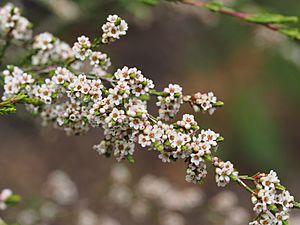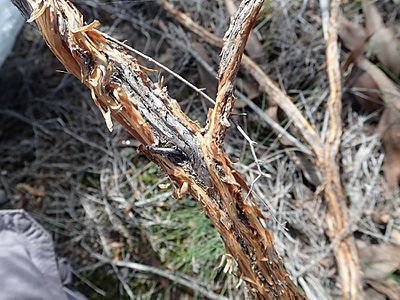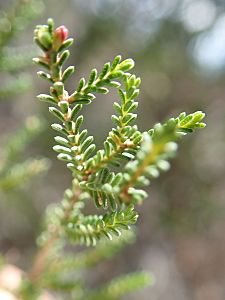Micromyrtus sessilis facts for kids
Quick facts for kids Micromyrtus sessilis |
|
|---|---|
 |
|
| Micromyrtus sessilis growing in the Bolivia Hill Nature Reserve south of Tenterfield | |
| Scientific classification | |
| Genus: |
Micromyrtus
|
| Species: |
sessilis
|
 |
|
| Occurrence data from AVH | |
Micromyrtus sessilis is a special plant from the myrtle family, called Myrtaceae. It's a type of plant that only grows naturally in eastern Australia. This plant is a bushy shrub that spreads out. It has small, thin leaves and flowers that can grow alone or in tight groups along its branches. It looks a bit like another plant called Micromyrtus ciliata, but Micromyrtus sessilis is found more in the northern parts of Australia.
Contents
What Does Micromyrtus sessilis Look Like?
Micromyrtus sessilis is a thick, spreading shrub. It usually grows to be about 0.5–1.5 m (2–5 ft) tall. Its younger stems are covered in tiny hairs.
Leaves and Stems
The leaves are long and narrow, like a line. They are also sometimes shaped like a spear, with the narrow end at the bottom. Each leaf is about 1.5–3 mm (0.06–0.1 in) long and less than 1 mm (0.04 in) wide. They have a short stalk, called a petiole, which is about 1 mm (0.04 in) long.
Flowers
The flowers of Micromyrtus sessilis can grow in a few ways. Sometimes, a single flower grows where a leaf meets the stem. Other times, they form small groups or even dense clusters along the branches.
At the base of each flower, there are two small, leaf-like parts called bracteoles. These bracteoles fall off as the flower opens up. The base of the flower, called the floral cup, is shaped like a cone. It has rounded ridges on its sides.
The sepals, which are like small leaves that protect the flower bud, are less than 1 mm (0.04 in) long. The petals, which are the colorful parts of the flower, are white to light pink. They are round or oval-shaped and about 1–1.5 mm (0.04–0.06 in) long. Each flower has five stamens, which are the parts that produce pollen. These stamens are about 1–1.5 mm (0.04–0.06 in) long. This plant mostly flowers in September and October.
How Was Micromyrtus sessilis Named?
The plant Micromyrtus sessilis was first officially described in 1983. This was done by a botanist named John Green. He studied a plant sample found near Miles. The description was then published in a science journal called Nuytsia.
Meaning of the Name
The second part of the plant's scientific name, sessilis, comes from a Latin word. It means "sitting." This name was chosen because the flowers of this plant have a very short stalk, or sometimes no stalk at all. This makes them look like they are "sitting" directly on the branch.
Where Does Micromyrtus sessilis Grow?
This plant grows in eastern Australia. You can find it between Miles in Queensland and Griffith in New South Wales. It usually grows in areas that are higher than 600 m (2,000 ft) above sea level.
Habitat
Micromyrtus sessilis can live in different types of places. It grows in areas with mallee (a type of eucalyptus forest) and also in other forests. It is often found in rocky areas.
Images for kids




